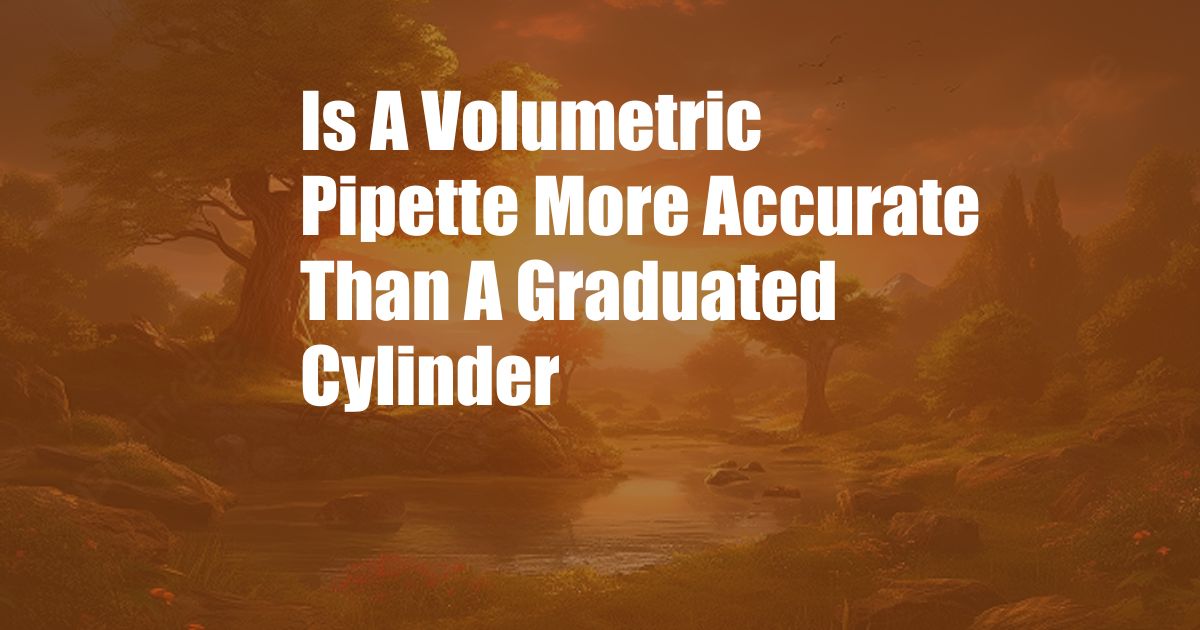
Is a Volumetric Pipette More Accurate Than a Graduated Cylinder?
Have you ever had to measure precise volumes of liquids in the lab and wondered which equipment to use? When it comes to accuracy, volumetric pipettes and graduated cylinders are two commonly used tools. But which one should you choose? In this detailed guide, we’ll delve into the world of volumetry and uncover the differences between these two essential lab instruments.
Understanding Volume Measurement
Before we compare the accuracy of these tools, let’s first understand the fundamentals of volume measurement. Volume is the amount of three-dimensional space occupied by a substance. In the lab, we often measure volumes using calibrated glassware, such as pipettes and graduated cylinders.
Volumetric Pipettes: Precision Dispensing
Volumetric pipettes are designed to dispense precise volumes of liquid. They come in various sizes, ranging from 0.1mL to 100mL. Each pipette is calibrated to a specific volume, meaning it delivers an exact quantity of liquid when filled to the calibration mark. Volumetric pipettes are commonly used for preparing and dispensing solutions that require high accuracy.
Graduated Cylinders: Measuring Volumes
Graduated cylinders are cylindrical-shaped glassware used to measure variable volumes of liquid. They are marked with graduated lines along their length, indicating different volumes. Graduated cylinders come in various sizes, typically ranging from 5mL to 1000mL. They are commonly used for measuring approximate volumes or preparing solutions that do not require high precision.
Accuracy Comparison: Volumetric Pipettes vs Graduated Cylinders
When it comes to accuracy, volumetric pipettes have a clear advantage over graduated cylinders. Volumetric pipettes are designed to deliver a specific volume with a high degree of accuracy. They use a single calibration mark to dispense the liquid, eliminating errors associated with reading multiple graduations.
On the other hand, graduated cylinders have inherent limitations in accuracy. The lines on graduated cylinders can be difficult to read precisely, especially for small volumes. Additionally, the meniscus of the liquid (the curved surface formed by the liquid) can introduce some error when determining the volume.
To illustrate this difference, let’s compare the accuracy of a 10mL volumetric pipette and a 10mL graduated cylinder. The volumetric pipette will consistently deliver 10mL of liquid with a high degree of accuracy. However, using the graduated cylinder, it may be possible to measure volumes slightly below or above 10mL due to the limitations discussed above.
Latest Trends and Developments
In the realm of volumetry, advancements in technology have brought about innovative tools that enhance accuracy and efficiency. One notable development is digital pipettes. These pipettes incorporate digital displays that precisely measure and dispense liquid volumes. Digital pipettes minimize errors associated with manual reading and reduce the chance of human mistakes.
Another emerging trend is the use of automated liquid handling systems. These systems use robotic arms or other automated mechanisms to dispense precise volumes of liquid. Automated liquid handling systems are particularly beneficial for high-throughput applications or assays that require multiple liquid transfers.
Tips and Expert Advice
To ensure accurate volume measurement, follow these expert tips:
- Calibrate your volumetric pipettes and graduated cylinders regularly.
- Use the correct pipetting technique to avoid introducing air bubbles or splashing liquid during dispensing.
- Ensure the pipette tip is fully inserted into the liquid to create a proper seal.
- Read the meniscus of the liquid at eye level to avoid parallax errors.
- Use clean and dry glassware to prevent contamination or inaccuracies.
FAQ
Q: Can I use a graduated cylinder to dispense a precise volume of liquid?
A: Graduated cylinders are not as accurate as volumetric pipettes for dispensing precise volumes. They are better suited for measuring approximate volumes.
Q: How do I prevent errors when using a graduated cylinder?
A: Read the meniscus at eye level, use a clean and dry graduated cylinder, and estimate volumes between the graduations as accurately as possible.
Q: What is the difference between a Class A and Class B volumetric pipette?
A: Class A pipettes meet higher accuracy standards and have tighter tolerances than Class B pipettes. Class A pipettes are typically used for precise measurements in analytical chemistry, while Class B pipettes are suitable for general laboratory use.
Conclusion
When it comes to measuring volumes in the lab, the choice between a volumetric pipette and a graduated cylinder depends on the required accuracy. For high-precision applications, volumetric pipettes offer superior accuracy and deliver specific volumes with minimal error. If approximate measurements are sufficient, graduated cylinders provide a convenient and versatile option for measuring liquids. By understanding the differences and following best practices, you can ensure accurate and reliable volume measurement in your laboratory work.
Interested in learning more about volumetric pipettes and graduated cylinders? Explore our online resources or connect with us for further guidance.